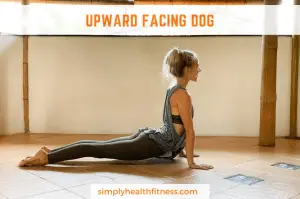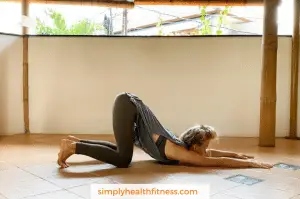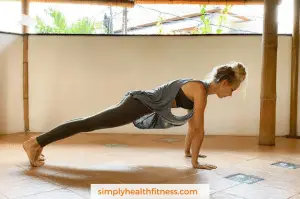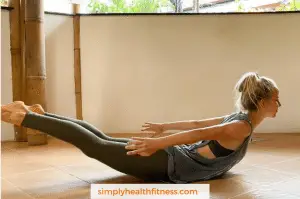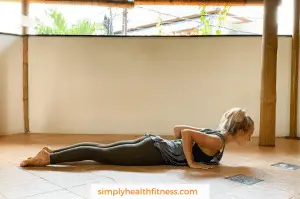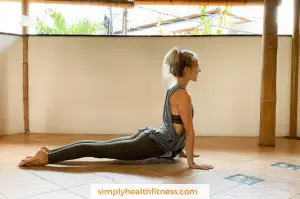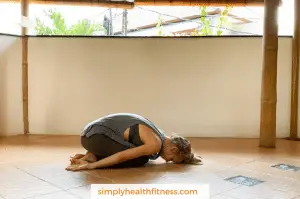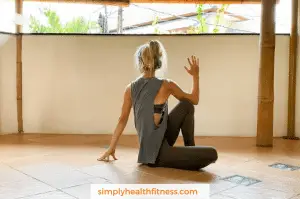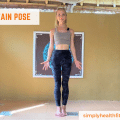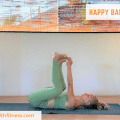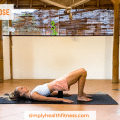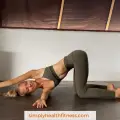“Urdhva Mukha Svanasana” (also known as “Upward Facing Dog” or “Updog”), is one of the key, foundational poses in yoga. It is one of the poses in the traditional Sun Salutation sequence of any modern yoga practice but takes practice, strength, and flexibility to perform it correctly. Once you have the tools to enter and perform this pose with proper form, you can then reap the multitude of benefits it offers.
Knowing how to do this pose, and unlocking the other poses that are included in the traditional Sun Salutation sequence will also set you up for practicing all types of yoga, beyond Hatha and Yin.
Practicing yoga consistently will give you the physical strength, mobility, and balance in your body that benefits your posture, organ function, and healthy aging. Furthermore, the breathwork that you do in yoga is linked to improving stress levels, focus, mental clarity, and sleep.
Step by step guide
Warm Up
Before attempting any pose in yoga, make sure that your body is warm, especially the key muscle groups you will be using.
Puppy Pose (Uttana Shishosana)
This pose will gently open up your chest and hips to prepare for the backbend during upward facing dog. From table top, simply walk your hands forward, about a foot further than they were, and lower your chest to the floor. Reach your arms long, and keep your hips up to deepen the spinal stretch. Hold this pose for 5-10 breaths.
High Plank Pose (Kumbhakasana)
The High Plank will fire up your abdomen and upper arms; it also helps with mind-to-muscle connection for proper alignment and posture. Get into the high plank from a table top position, by taking your knees off the floor and straightening your legs back. Align your wrists under your shoulders and toes tucked. Engage the core by sucking your navel into your spine, and spread your weight evenly throughout your palms and fingers. There should be a long line from your head to the tops of your feet, without sagging your hips or space between your shoulder blades. Hold this pose for up to 10 breaths to get the heat building.
Locust Pose (Salabhasana)
The Locust pose is great for building back strength and for opening the chest. It also warms up the glutes and hamstrings for when you do the upward dog. Start by lying on your stomach with your legs long behind you, at hip distance apart. Place your arms along the sides of your body, and point the tops of your feet. Use your back muscles and glutes to lift your chest and arms off the floor. You can even try to lift your legs off the floor while you keep reaching your arms back. Keep your head straight and look in front of you, and feel your chest open and shoulders peel back. Hold this pose for 5 breaths, and try to repeat it a couple more times.
How to do the Upward facing dog
1. Begin by lying face down on the mat, with your legs straight behind you and hip distance apart.
2. Place your palms under your shoulders, and keep your elbows close to your body.
3. On an inhale, press your palms, fingers, and tops of your feet to the floor and straighten your arms to lift your chest, pelvis, and legs about an inch above the mat.
4. Make sure that your back muscles and thighs are engaged.
5. To adjust your wrists under your shoulders, move your feet closer or further away from you.
6. Keep your gaze ahead of you and open your pectorals to keep your shoulders rolled back and away from your ears.
7. Stay in this pose for 5 breaths before you take a short rest.
Check out my video tutorial for more tips on how to do the Upward Facing Dog:
Counter Poses
After practicing certain poses, make sure to always balance your movement with counter stretches to prevent stiffness and soreness.
1. Childs Pose variation (Balasana): Sit back on your knees, rest your body forward, and straighten your arms back along the sides of your body. With this more passive variation of childs pose, you are able to relax your spine and shoulders. Hold this for 10 breaths.
2. Half Lord of the Fishes (Ardha Matsyendrasana): This twist will decompress your back and spinal joints. Bend both knees, with your right knee up and your left knee down and off to the side. Lengthen your spine as you twist to the right and place your right hand behind you. Tuck your left elbow outside of your right knee to deepen the twist and take your gaze behind you without leaning back. Hold this for 5 breaths on each side.
How to Perfect the Upward Facing Dog Pose
Variations and Modifications
Hands on blocks: Place a block under each of your palms to keep the elevation while decreasing the intensity of the pose.
Toe Grip: Your toes can be pointed or tucked, and each variation will let you feel the pose differently.
Vinyasa Transition: You can advance your practice by practicing this transition:
- High plank to low plank (chaturanga), with knees on or off the floor
- Low plank to upward facing dog
- Upward facing dog to downward facing dog
Sun Salutations: When you are familiar with the transitions, you can practice the sun salutations. Beginners do 3-5 rounds of sun salutation A, while advanced practitioners will do up to 5-10 rounds of both sun salutation A and B, which has more postures.
Advanced Poses
Once you have increased the strength and flexibility in your back, hips, glutes, and hamstrings, here are some more advanced poses you can move on to.
- Bow Pose (Dhanurasana)
- Full Wheel Pose (Urdhva Dhanurasana)
- Dancers Pose (Natarajasana)
Upward Facing Dog vs Cobra Pose
The two poses are often confused because they may look the same but are actually quite different; knowing the differences are important in doing the poses with proper form.
Points of Contact
In the cobra pose, you will notice that your palms, pelvis, and the tops of your legs are on the floor. The muscle work here is focused on your back and glutes and is more accessible to beginners.
In the upward-facing dog, your whole body is hovering about an inch off the mat, with only your palms and tops of the feet on the floor, which requires more strength and flexibility.
Hand Placement
In the cobra pose, your hands are slightly in front of you, so that there is a diagonal line from your hands to your shoulders. This hand placement allows for a gentler and more adjustable backend.
With upward dog, your hands are under your shoulders, which requires a lot more spinal flexibility and is only ideal for those with healthy backs.
Use of Muscles
Because the cobra pose only lifts your chest, there is more tension on the back, glutes, and inner thighs.
The upward dog, however, targets your upper arms and thighs to help lift your body, while also working your back muscles. Because more weight is lifted, it’s important to note that your back will be more loaded in upward dog.
Back Curvature
The cobra pose is more beginner-friendly because it has less of a backbend than the upward-facing dog. The cobra pose can help you increase the backbend step by step, by simply straightening the elbows more.
Once you have developed more strength and flexibility in the back, you can then try out the upward facing dog.
Key Benefits of Upward Facing Dog
When you enter the upward-facing dog pose, you will be stretching your pectoral muscles which will reduce tension in the neck, shoulders, and back that build up as a result of slouching. Eradicating your slouch has also been found to increase confidence and have an empowering effect. In a more spiritual sense, opening the heart is believed to give you access to feelings of love, kindness, and compassion for others as well as yourself.
Upper Body Strength
The strength that you achieve with practicing the upward-facing dog, will help you unlock many more arm balances in yoga. The reason that the upward dog is a great pose to start with is that it works the arm muscles while also keeping an awareness of not pressuring the elbows. Furthermore, upper arm strength benefits other athletes, even cyclists, runners, hikers, etc., as it helps with propulsion and stability.
Benefits of Sun Salutations and Transitions
With upward-facing dog being one of the key poses in a sun salutation, knowing how to do it in the context of the sequence will help. Sun Salutations are the perfect warm-up for any exercise you choose to do – yoga or not.
Working on the transitions within a sun salutation will prepare you for classes that are dynamic and have a consistent flow, such as Vinyasa and Ashtanga vinyasa. While Hatha yoga is great for beginners and can help build foundational strength and flexibility, the transitions of Vinyasa and Asthanga have more cardiovascular benefits (your joints are probably better off with this type of cardio than a HIIT workout anyway). The link of breath to movement throughout the entire flow also allows you to be more present and focused during the practice, which gives access to more calmness and tranquility post-workout.
Common Mistakes and Risks
Just like with every “new” pose, there are some common mistakes to avoid to practice safely. Backbends are known to be more delicate, as they can harm your spine if you don’t perform them properly. Therefore, make sure that you stop the pose if there is any pinching sensation and/or if you are compressing the lower back. Also, make sure you are pressing all the toes on the floor to provide more support for the back. Finally, don’t hunch the shoulders and keep your gaze forward to protect the back of the neck.
If you are recovering from surgery or have any injury, always consult a professional before attempting any type of exercise. This pose should not be performed by those suffering from shoulder, back, wrist, and neck issues. Because of its placement on the stomach, it is not recommended to be performed after the first trimester of pregnancy either.
Final Thoughts
With any pose in yoga, it is beneficial to know the positives as well as the potential negatives when done incorrectly. By attempting poses blindfolded, you can potentially hurt yourself; however, consistent and healthy yoga practice is incredibly rewarding for anyone – no matter your age or size. Therefore, it is strongly recommended to practice consistently and under proper guidance when first starting out so that you feel the beautiful results that come with it.
